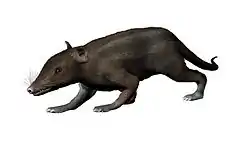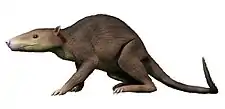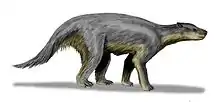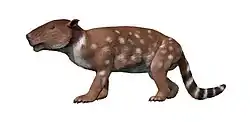Cimolestes
Cimolestes ("chalk robber")[1] is a genus of early eutherians with a full complement of teeth adapted for eating insects and other small animals. Paleontologists have disagreed on its relationship to other mammals, in part because quite different animals were assigned to the genus, making Cimolestes a grade taxon of animals with similar features rather than a genus of closely related ones. Fossils have been found in North America, where they first appeared during the Late Cretaceous. According to some paleontologists, they died out at the start of the Paleocene,[2] while others report the genus from the early Eocene.[3]
| Cimolestes | |
|---|---|
| Scientific classification | |
| Kingdom: | Animalia |
| Phylum: | Chordata |
| Class: | Mammalia |
| Order: | †Cimolesta |
| Family: | †Cimolestidae Marsh 1889 |
| Genus: | †Cimolestes Marsh 1889 |
| Type species | |
| †Cimolestes incisus Marsh 1889 | |
| Synonyms | |
|
Nyssodon Simpson 1927 | |
Most species have been described from teeth and isolated fragments. One complete articulated skeleton provisionally assigned to Cimolestes has been found. It shows a small, agile, tree-dwelling predator with long toes for grasping branches and a prehensile tail at least twice the length of its body. It has the largest number of tail vertebrae known in any mammal.[3]
Classification
The genus was once considered to be marsupials; later it was reclassified with the placental mammals, as ancestors of the Carnivora and the extinct Creodonta. Recent researchers have agreed the species assigned to Cimolestes are primitive eutherian mammals, members of a Cimolestid clade (an order or family named after the genus), part of the larger clade Didelphodonta (a superorder or order, not to be confused with the marsupial clade Didelphimorphia). Didelphodonts have been placed within the Ferae, as a sister group to Carnivora. However, consensus is emerging that modern placental mammals evolved later than previously thought,[4][5] that other types of mammals had long, diversified, and successful histories, and that Cimolestes and many related genera are stem eutherians, more closely related to placentals than to marsupials but outside of placental mammals proper, and not closely related to any living animal.[6]
Cimolestes in particular follows as the direct outgroup to Taeniodonta, indicating that the latter evolved from forms similar to it.[6]
Reassigned species
In order to make the genus reflect an actual group of most closely related species, three nominal species of Cimolestes, C. magnus, C. cerberoides, and C. propalaeoryctes, have been reassigned to their own genera, Altacreodus, Ambilestes, and Scollardius, respectively. Cimolestes incisus Marsh and Cimolestes stirtoni Clemens remain within the genus.[7]
Fossil distribution
Fossils of Cimolestes have been found in:[8]
- Cretaceous
- Canada
- Foremost, Oldman and St. Mary River Formations, Alberta
- Ravenscrag and Frenchman Formations, Saskatchewan
- United States
- Hell Creek and Judith River Formations, Montana
- Kirtland Formation, New Mexico
- Lance Formation, Wyoming
- Paleocene
- Hainin Formation, Belgium
- Santa Lucía Formation (Tiupampan), Bolivia
- Ravenscrag and Frenchman Formations, Saskatchewan, Canada
- Jbel Guersif Formation, Morocco
- United States (Puercan)
- Bear and Hell Creek Formations, Montana
- Ferris Formation, Wyoming
- Eocene
- Fossil Butte Member, Green River Formation, Wyoming, United States[3]
References
- Palmer, T.S. (1904). "Index Generum Mammalium: a List of the Genera and Families of Mammals". North American Fauna. 23: 189. doi:10.3996/nafa.23.0001. Retrieved 2019-07-21.
- McKenna, M. C.; S. K. Bell (1997). Classification of Mammals Above the Species Level. Columbia University Press. ISBN 978-0-231-11012-9.
- Grande, Lance (2013). The Lost World of Fossil Lake; Snapshots from Deep Time. Chicago: University of Chicago Press. pp. 260–263. ISBN 9780226922966.
- O'Leary, Maureen A., Jonathan I. Bloch, John J. Flynn, Timothy J. Gaudin, Andres Giallombardo, Norberto P. Giannini, Suzann L. Goldberg, Brian P. Kraatz, Zhe-Xi Luo, Jin Meng, Xijun Ni, Michael J. Novacek, Fernando A. Perini, Zachary S. Randall, Guillermo W. Rougier, Eric J. Sargis, Mary T. Silcox, Nancy B. Simmons, Michelle Spaulding, Paúl M. Velazco, Marcelo Weksler, John R. Wible, and Andrea L. Cirranello. "The Placental Mammal Ancestor and the Post—K-Pg Radiation of Placentals." Science 339, no. 6120 (2013): 662-67. Accessed March 25, 2020. www.jstor.org/stable/23365914.
- O'Leary, Maureen A. "On the Trail of the First Placental Mammals." American Scientist 102, no. 3 (2014): 190-97. Accessed March 25, 2020. www.jstor.org/stable/43707184.
- Rook, D.L.; Hunter, J.P. (2013). "Rooting Around the Eutherian Family Tree: the Origin and Relations of the Taeniodonta". Journal of Mammalian Evolution. 21: 1–17. doi:10.1007/s10914-013-9230-9.
- Richard C. Fox (2015) A revision of the Late Cretaceous–Paleocene eutherian mammal Cimolestes Marsh, 1889. Canadian Journal of Earth Sciences (advance online publication) doi: 10.1139/cjes-2015-0113 http://www.nrcresearchpress.com/doi/abs/10.1139/cjes-2015-0113?src=recsys#.VkAcsrerTcs
- Cimolestes at Fossilworks.org





